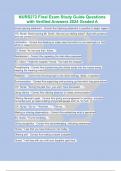NURS272 Final Exam Study Guide Questions
with Verified Answers 2024 Graded A
broad opening statement - Correct Ans-Opening statement or question to begin rapport.
EX: Nurse: Good morning Mr. Smith. How are you feeling today? (Said with presence
and eye contact)
clarification - Correct Ans-Seeking to make clear that which is not meaningful or that
which is vague
EX: Nurse: "Im not sure that I follow..."
Restatement - Correct Ans-repeating the main idea expressed
EX: Client: "I hate this hospital." Nurse: "You hate this hospital"
Paraphrasing - Correct Ans-transforming the clients words into the nurses words,
keeping the meaning intact
Reflection - Correct Ans-Directing back to the client feelings, ideas, or questions
Summarization - Correct Ans-organizing and summing up that which has gone before
EX: Nurse: "During the past hour, you and I have discussed......"
Using silence - Correct Ans-utilizing absence of verbal communication
Offering General Leads - Correct Ans-giving encouragement to continue. Includes
nonverbal such as head nodding and paralanguage such as "uh huh".
EX: Nurse: "Go on." "And then....." "Tell me...."
Making or sharing observations - Correct Ans-verbalizing what is perceived
EX: Nurse: "You're trembling...."
Giving recognition - Correct Ans-acknowledging, indicating awareness
Nurse: "I see that you have fixed your hair today."
Offering self - Correct Ans-making oneself available
Nurse: "I will stay with you until your daughter gets here."
,Encouraging description of perception - Correct Ans-encouraging patient to describe
how he sees the situation & its meaning for him
Nurse: "What is your understanding about what the doctor just shared with you? What
does this mean for you & your family right now?"
Encouraging comparison - Correct Ans-asking that similarities and differences be noted
Nurse: "How is this pain compared to what you experienced last night?"
Focusing - Correct Ans-concentrating on a single specific point
Exploring - Correct Ans-delving further into a subject or idea
EX: Nurse: "Tell me more about how you are feeling now"
Giving information - Correct Ans-making available the facts that the patient needs
Nurse: "It is unlikely that you will be able to go home until you have finished these new
tests that your doctor told you about."
Verbalizing the implied - Correct Ans-voicing what the client has hinted at or suggested
Client: "I can't talk to you or anyone. It's a waste of time."
Nurse: "Do you feel that no one understands?"
Seeking validation - Correct Ans-searching for mutual understanding
Nurse: "You seem to be feeling better now after your bath." Or "I believe you are telling
me that......."
Acknowledge - Correct Ans-Acknowledging what the client has said
Nurse: "im sorry"
Sharing - Correct Ans-Sharing your personal experiences AS APPROPRIATE. Use
sparingly and
only when appropriate. This technique must be used for the client's benefit and
not to meet the nurse's needs. *Can easily be a block*
Closing - Correct Ans-statements at the end of an interaction that close in a meaningful
way
therapeutic communication - Correct Ans-communication that is goal directed and
focused dialogue between nurse and patient. involves exchange of ideas, feelings, and
attitudes related to desired heath outcomes.
,characteristics and purpose of therapeutic communication - Correct Ans-1. client
centered
2. goal directed
3. defined rules and boundaries
4. individualized strategies: nurse adjusts approaches as needed
5. nonjudgemental
timing of therapeutic communication - Correct Ans-1. emotional readiness: low
readiness
2. energy conservation: remember Maslow
characteristics of verbal communication - Correct Ans-1. words are symbols used to
think about ideas, share, and validate meaning. letters are symbols of vocalizations
2. differences influence communication
3. paralanguage
4. slang/jargon
paralanguage - Correct Ans-vocalic behaviors that communicate meaning along with
verbal behavior
characteristics of nonverbal communication - Correct Ans-1. body language often
conveys true emotions
2. cultural/gender differences
3. cues/facial expressions (posture, rhythm of moves, gestures, stance, eye contact)
4. clothing/grooming (tells about mental status, SES, etc)
active listening - Correct Ans-1. hear client message: beyond listening
2. decode its meaning
3. provide feedback concerning nurse's understanding of message
4. SOLER
SOLER - Correct Ans-demonstrate active listening.
S: sit square or at an angle so you face person
O: open posture, not crossing arms/legs
L: lean forward a bit
E: eye contact to comfort of patient
R: relax, no fidgeting
Questions to start therapeutic communication - Correct Ans-open-ended, closed,
focused,
open ended questions - Correct Ans-open to interpretation. start with how, what, where,
where but NEVER use why
closed questions - Correct Ans-yes or no info. start with do, will, can
, focused questions - Correct Ans-limiting, but answer is more than yes or no
communication assessment - Correct Ans-1. verbal: fluency, accents, organization2. 2.
written: able to write/read? how much/what level/how well
3. nonverbal
4. environment: hospital, clinic, LTC, community, home, etc
communication considerations with infants - Correct Ans-nonverbal, gentle motion,
parents are partners, slow and soft voice, sit level or hold in arms
communication considerations with toddlers (1-3) - Correct Ans-brief and clear, simple
complete sentences in their words, no baby talk, show hands, allow some choices,
address parents first
communication considerations with preschoolers (3-5) - Correct Ans-simple words, brief
and concrete explanations, play therapy for explanations, provide choices, attending
posture, jokes
communication considerations with school age (5-10) - Correct Ans-include in care and
explanations, draw pics, use their words, privacy
communication considerations with 11+ - Correct Ans-abstract thinking used but
minimal, humor, privacy, state limits of confidentiality, allow decisions, attending
posture, active listening
communication considerations with elderly - Correct Ans--use correct titles
-include in conversation
-use normal voice/mannerisms (unless hearing impaired)
-touch-appropriate
-decreased energy level
communication considerations with visually impaired - Correct Ans--let them know when
entering/leaving
-use normal voice
-explain touching before done
-orient to evironmet
-stay in visual field if partial vision
-ambulate with them holding your arm
-may use braille, audiobooks, music
communication considerations with hearing loss - Correct Ans--orient pt to presence
using vision/touch
-hearing aids
-position so they can see you
-don't cover your face




